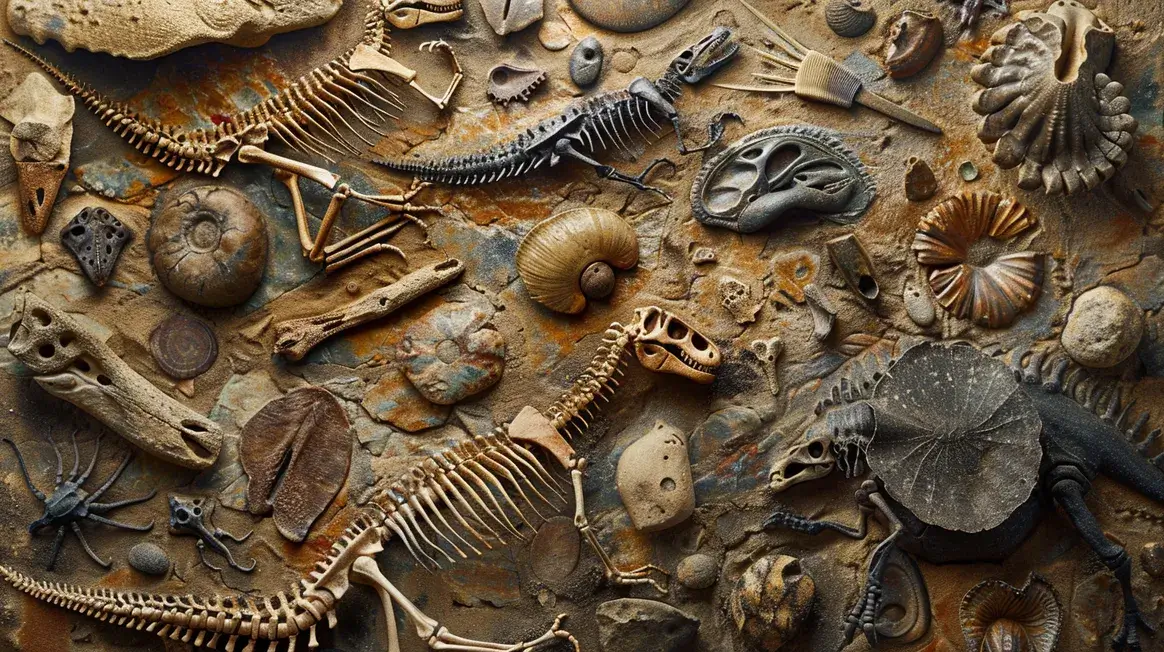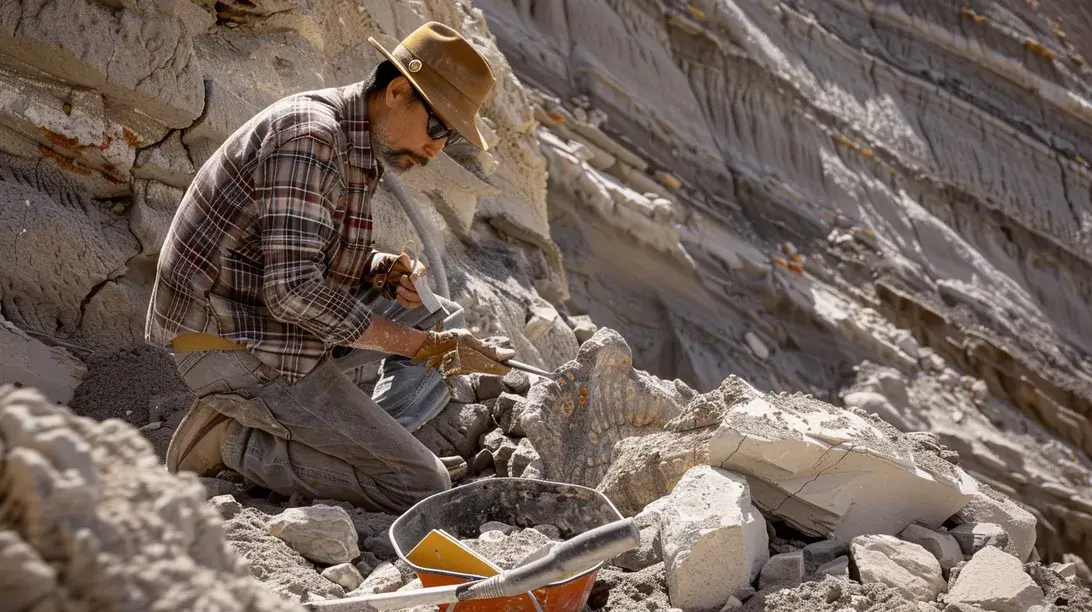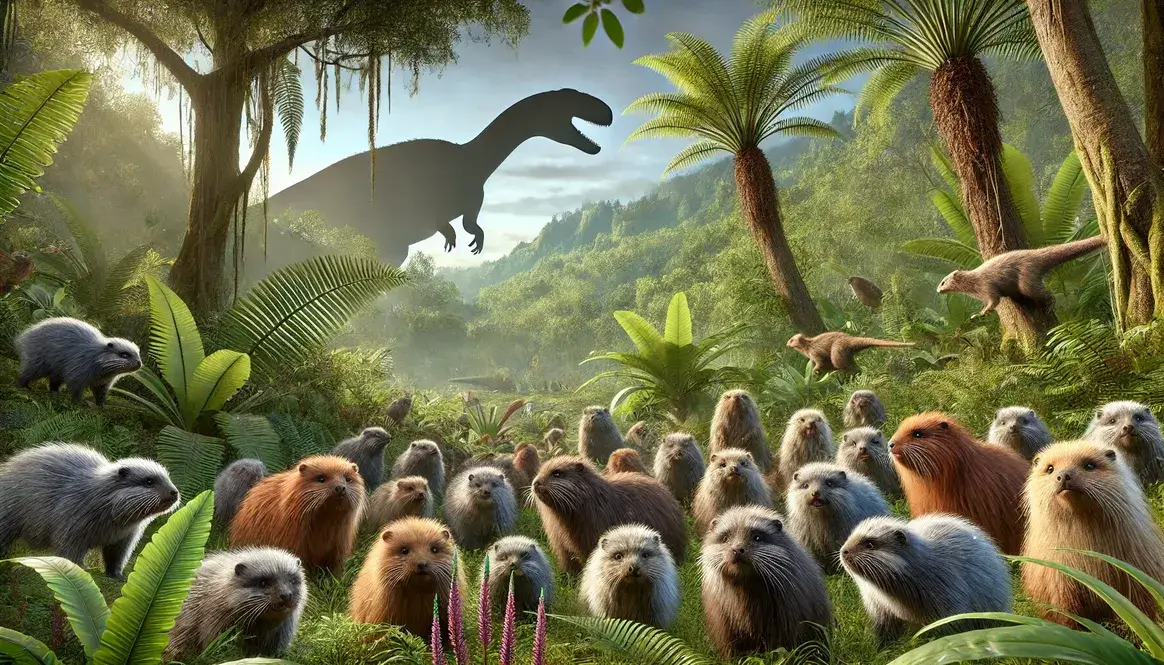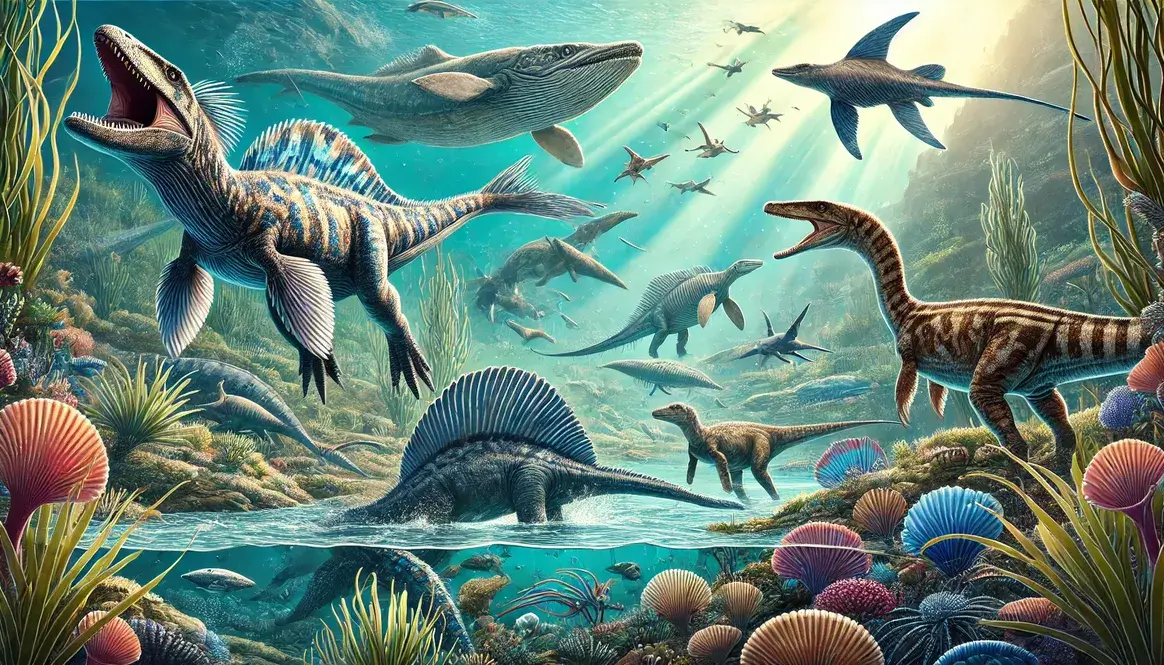The Jurassic-Cretaceous transition marks a pivotal moment in Earth’s history, a time when our planet underwent significant changes that set the stage for the rise of many familiar dinosaur species. This period, occurring roughly 145 million years ago, was a turning point that saw dramatic shifts in climate, geography, and the creatures that roamed the Earth.
Setting the Stage: Late Jurassic Landscapes
Before we dive into the Jurassic-Cretaceous transition, let’s take a quick trip back in time to the Late Jurassic period. Imagine a world very different from the one we know today, where massive dinosaurs ruled the land and strange creatures swam in the seas.
Dominant Life Forms
The Late Jurassic was a time of giants. On land, huge sauropods like Brachiosaurus and Diplodocus lumbered across the landscape, their long necks reaching high into the trees. These plant-eaters shared their world with fearsome predators like Allosaurus, a large carnivore that was one of the top predators of its time.
In the seas, strange reptiles called plesiosaurs and ichthyosaurs ruled the waves. These weren’t dinosaurs, but they were just as impressive. Plesiosaurs had long necks and paddle-like limbs, while ichthyosaurs looked a bit like modern dolphins.
The skies weren’t empty either. Pterosaurs, flying reptiles (but not dinosaurs), soared overhead. Some were as small as sparrows, while others had wingspans as wide as a small plane!
Plants were different too. Ferns, cycads, and conifers were common, but flowering plants hadn’t yet taken over the world.
Climate and Geography
The Late Jurassic world was generally warmer than today, with no polar ice caps. This meant sea levels were higher, and much of the land was covered by shallow seas.
The continents were still bundled together in a supercontinent called Pangaea, but it was starting to break apart. This breakup would continue through the Jurassic-Cretaceous transition and beyond, shaping the world we know today.
Here’s a quick comparison of the Late Jurassic and modern climates:
| Feature | Late Jurassic | Modern Day |
|---|---|---|
| Average Global Temperature | 3-5°C warmer | Current baseline |
| Polar Ice Caps | Absent | Present |
| Sea Levels | Much higher | Lower |
| CO2 Levels | 4-5 times higher | Current levels |
The Jurassic-Cretaceous Transition: Defining the Boundary
Now, let’s zoom in on the Jurassic-Cretaceous transition itself. But how do scientists know where the Jurassic ends and the Cretaceous begins? It’s not like there was a big sign saying “Welcome to the Cretaceous” 145 million years ago!
Geological Markers
Scientists use several methods to identify the Jurassic-Cretaceous boundary:
- Rock Layers: Different rock types form under different conditions. By studying the layers of rock (called strata), scientists can spot changes that mark the boundary.
- Magnetic Reversals: Earth’s magnetic field has flipped many times in the past. These flips are recorded in rocks, creating a sort of “barcode” that scientists can read.
- Chemical Signatures: Certain chemical elements in rocks can indicate major events or changes in the environment.
One key marker is a thin layer of clay found in many parts of the world. This clay is rich in iridium, an element that’s rare on Earth but common in asteroids. Some scientists think this might be evidence of an asteroid impact right at the Jurassic-Cretaceous boundary.
Key Fossil Evidence
Fossils are like nature’s time capsules, giving us glimpses of life in the past. The Jurassic-Cretaceous boundary is marked by changes in the types of fossils found above and below it.
Some key fossil evidence includes:
- Microfossils: Tiny fossils of plankton show rapid changes at the boundary.
- Ammonites: These squid-like creatures with coiled shells evolved quickly, making them useful for dating rocks.
- Plant Spores: Changes in the types of plant spores found in rocks help mark the boundary.
Dinosaur fossils also provide clues. Some dinosaur groups common in the Jurassic become rare or extinct in the early Cretaceous, while new groups start to appear.
By piecing together all these clues, scientists have been able to draw a line in the rock record and say, “This is where the Jurassic ended and the Cretaceous began.”
Changing Continents: Tectonic Shifts
The Jurassic-Cretaceous transition wasn’t just about the creatures living on Earth – the planet itself was going through some major changes. Imagine the ground beneath your feet slowly shifting and moving over millions of years. That’s exactly what was happening during this time!
Pangaea’s Continued Breakup
Remember Pangaea, that giant supercontinent we talked about earlier? Well, during the Jurassic-Cretaceous transition, it was in the middle of a very slow-motion breakup. Here’s what was happening:
- North America started to drift away from Europe, creating the beginnings of the North Atlantic Ocean.
- South America began its long journey away from Africa, forming the South Atlantic.
- India broke free from the southern supercontinent Gondwana and started its northward trek.
- Australia and Antarctica were still connected but were moving away from Africa.
These continental movements had big effects on the world’s ecosystems. As landmasses drifted apart, animal and plant populations were separated. This isolation led to the evolution of new species unique to each continent – a process called endemism.
Sea Level Fluctuations
As the continents moved, sea levels were also changing. During the Jurassic-Cretaceous transition, sea levels were generally high, but they didn’t stay constant. They rose and fell, reshaping coastlines and creating new habitats.
Here’s a quick look at how these sea level changes affected the world:
| Effect | Impact |
|---|---|
| Creation of shallow seas | New habitats for marine life |
| Flooding of low-lying areas | Formation of new islands |
| Changes in ocean currents | Altered global climate patterns |
| Expansion of coral reefs | Increased biodiversity in tropical seas |
These changes had a huge impact on both marine and terrestrial life. For example, the high sea levels created many shallow, warm seas perfect for reef-building organisms. On land, changing coastlines forced animals and plants to adapt or move, driving evolution and migration.
Climate Shifts: From Jurassic to Cretaceous
Just like the continents were on the move, the Earth’s climate was also shifting during the Jurassic-Cretaceous transition. These changes played a big role in shaping the Cretaceous world that would follow.
Temperature Trends
The Jurassic-Cretaceous transition saw some interesting temperature changes:
- Overall cooling: The very warm climate of the Jurassic started to cool off a bit. Don’t get the wrong idea, though – it was still much warmer than today!
- More varied temperatures: While the Jurassic was pretty warm all over, the Cretaceous started to see more temperature differences between the equator and the poles.
- Seasonal changes: As continents spread out, some areas started to experience more pronounced seasons.
These temperature shifts had big effects on plants and animals. Some species that liked it hot had to adapt or move to stay in their preferred climate. Others found new opportunities in areas that were previously too warm for them.
Precipitation Patterns
Along with temperature changes, the Jurassic-Cretaceous transition also saw shifts in rainfall patterns:
- Increased rainfall in many areas, especially near the coasts of the new oceans forming between the continents.
- More varied rainfall across different regions. Some areas became wetter, while others dried out.
- Monsoon systems started to develop in some parts of the world.
These changes in rainfall had a huge impact on plant life. Areas with more rain saw lush forests grow, while drier regions saw the spread of plants adapted to less water. These plant changes, in turn, affected the animals that depended on them for food and shelter.
All these climate shifts created a world that was becoming more diverse and complex – setting the stage for the incredible diversity of life we see in Cretaceous fossil records. It’s amazing to think how these gradual changes over millions of years shaped the course of life on Earth!
Plant Life in Transition
The Jurassic-Cretaceous transition wasn’t just about big dinosaurs and shifting continents. The plant world was going through its own revolution, setting the stage for the lush, diverse ecosystems of the Cretaceous.
Decline of Certain Jurassic Plants
As the world changed, some plant groups that had thrived in the Jurassic period began to lose their dominance. These included:
- Bennettitales: These seed plants, which looked a bit like cycads, had been common in the Jurassic but started to decline.
- Certain ferns: While ferns as a group continued to thrive, some Jurassic species couldn’t adapt to the changing conditions.
- Some conifers: Certain types of conifers that had been widespread in the Jurassic became less common.
These changes didn’t happen overnight. It was a gradual process, with some plants hanging on in certain areas while disappearing from others.
Rise of New Plant Types
As some plant groups declined, others rose to take their place. The big stars of this botanical show were the angiosperms – flowering plants. While they first appeared in the Late Jurassic, it was during the Jurassic-Cretaceous transition that they really started to make their mark.
Flowering plants brought some big changes to the plant world:
- Faster reproduction: Angiosperms could reproduce more quickly than many other plant types.
- New habitats: They could grow in a wider range of environments.
- Co-evolution: Flowering plants developed close relationships with insects, leading to new forms of pollination.
But it wasn’t just about flowers. Other plant groups were evolving too:
- New types of conifers appeared, better adapted to the changing climate.
- Ginkgos, which had been around since before the dinosaurs, diversified into new species.
- Ferns continued to thrive, with new species emerging.
These changes in plant life had a huge impact on the animals of the time. The spread of flowering plants provided new food sources and habitats, influencing the evolution of insects, early mammals, and even some dinosaurs.
Animal Life: Evolving Fauna
Just as the plant world was changing, the animal kingdom was going through its own transformations during the Jurassic-Cretaceous transition. From the depths of the oceans to the lands and skies, life was evolving in fascinating ways.
Marine Life Transformations
The oceans were a hotbed of evolution during this time. Here’s a quick dive into the changes:
- Rise of modern fish: Teleost fish, which make up most of today’s fish species, began to diversify.
- Ammonite evolution: These shelled cephalopods, distant relatives of today’s squids, underwent rapid evolution.
- Marine reptile shifts: While Jurassic sea monsters like plesiosaurs and ichthyosaurs were still around, new groups like mosasaurs were beginning to appear.
| Marine Group | Jurassic Dominance | Early Cretaceous Trend |
|---|---|---|
| Plesiosaurs | High | Declining |
| Ichthyosaurs | High | Stable |
| Mosasaurs | Absent | Emerging |
| Teleost fish | Low | Increasing |
Terrestrial Animal Evolution
On land, the story was all about dinosaurs. The Jurassic-Cretaceous transition saw some major shifts in dinosaur populations:
- Sauropods: While still important, the giant Jurassic sauropods like Brachiosaurus were giving way to new groups.
- Theropods: New types of meat-eating dinosaurs were evolving, setting the stage for the famous tyrannosaurs of the Late Cretaceous.
- Ornithischians: Plant-eating dinosaurs like stegosaurs were declining, while new groups like early horned dinosaurs were on the rise.
But dinosaurs weren’t the only land animals changing. Crocodile relatives were diversifying, and new types of lizards and turtles were appearing.
Early Birds and Mammals
This period was crucial for two groups that would go on to dominate the post-dinosaur world: birds and mammals.
Birds, which had first appeared in the Late Jurassic with Archaeopteryx, were starting to diversify. New bird groups were evolving, some still with teeth and clawed wings, others more like modern birds.
Mammals, which had been around since before the dinosaurs, were also changing. While still small, early mammals were diversifying into new forms, including the ancestors of modern mammal groups.
The Jurassic-Cretaceous transition was a time of great change for life on Earth. Old groups declined, new ones arose, and the foundations were laid for the incredible diversity of the Cretaceous period. It’s a testament to the constant change and adaptation that characterizes life on our planet.
Key Evolutionary Trends
The Jurassic-Cretaceous transition was a time of significant evolutionary change. Let’s explore some of the major developments that shaped life during this period.
Dinosaur Diversification
Dinosaurs, already the dominant land animals, underwent a burst of evolution during this transition. New groups emerged, while existing ones adapted and changed. Here’s a snapshot of the dinosaur world in flux:
- Theropods:
- Early tyrannosaurs appeared, still small but with the potential for greatness.
- Carnosaurs like Allosaurus gave way to new predators.
- Feathered dinosaurs became more diverse, paving the way for true birds.
- Sauropods:
- Giant diplodocids declined, but new groups like titanosaurs began to emerge.
- These new sauropods were adapting to changing plant life and environments.
- Ornithischians:
- Early ceratopsians (horned dinosaurs) and pachycephalosaurs (dome-headed dinosaurs) appeared.
- Stegosaurs declined, while ankylosaurs (armored dinosaurs) diversified.
This diversification set the stage for the incredible variety of dinosaurs we see in Cretaceous fossils. It’s like nature was experimenting with new dinosaur designs!
Adaptations to Changing Environments
As the world changed, animals and plants had to change with it. Here are some key adaptations that emerged:
- Heat regulation: With fluctuating temperatures, some dinosaurs may have developed better ways to control their body heat.
- Water conservation: In areas becoming drier, plants evolved ways to retain water, like waxy leaf coatings.
- New diets: As flowering plants spread, some animals evolved to eat and pollinate them.
- Migration abilities: With shifting continents and climates, many animals likely developed better migration capabilities.
These adaptations weren’t just limited to dinosaurs and plants. Marine life, early mammals, and flying reptiles were all evolving to meet the challenges of their changing world.
Looking Forward: Setting the Stage for the Cretaceous
The Jurassic-Cretaceous transition was like a dress rehearsal for the Cretaceous period. Many of the stars of the Cretaceous – tyrannosaurs, horned dinosaurs, flowering plants – made their debut during this time.
Here’s how the transition period set the stage for the Early Cretaceous world:
| Aspect | Jurassic-Cretaceous Transition | Early Cretaceous Result |
|---|---|---|
| Climate | Cooling trend begins | Generally cooler, more varied climate |
| Geography | Continents separating | Increased endemism (unique species in different areas) |
| Plant life | Angiosperms emerging | Flowering plants become dominant |
| Dinosaurs | New groups appearing | Greater dinosaur diversity |
| Marine life | Modern fish groups evolving | Teleost fish become prevalent |
The changes during the transition didn’t stop when the Cretaceous officially began. Evolution continued, building on the foundations laid during this crucial time. The world was becoming more like the one we know from Cretaceous fossils – a world of T. rex and Triceratops, of flowering meadows and seas teeming with new forms of life.









